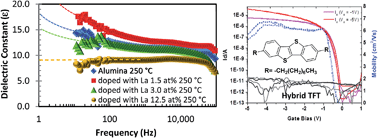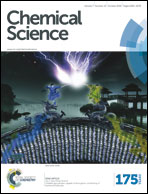Identification of dipole disorder in low temperature solution processed oxides: its utility and suppression for transparent high performance solution-processed hybrid electronics†
Abstract
The ability to deposit high-quality inorganic semiconductors and dielectrics from solution at low process temperatures (∼200 °C) has become a very important research focus. During the course of our investigation, we identify the presence of an induced dipole present in solid state solution processed inorganic oxide insulator layers processed at reduced temperature (200–350 °C) from either molecular precursors, or well-dispersed metal oxide nanoparticles. Chemical composition analysis coupled with electrical measurements shows that the dielectric instability occurs due to proton migration via the Grotthuss mechanism inducing a long lived dipole disorder. Thus we established conditions for suppressing this effect to afford “ideal” high-k dielectric layer. Using this methodology, solution processed all inorganic thin film transistors (TFTs) with charge carrier mobilities exceeding 6 cm2 V−1 s−1 operating at low voltage (5 V) have been achieved. In addition, we show the broad utility of the perovskite high-k dielectric when processed with state of the art polymer and single crystal organic semiconductors yielding mobilities of approx. 7 cm2 V−1 s−1 at only 4 V. These transparent devices demonstrate excellent electrical device stability and a threshold voltage shift of only 0.41 V over 14 h, which is comparable, or better than sputtered oxide films.


 Please wait while we load your content...
Please wait while we load your content...